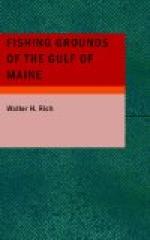Massachusetts Bay. The larger part of this ground, especially inside Stellwagens Bank, has a mud bottom, on which large quantities of fish are rarely taken. On the shore soundings between Boston Harbor and Plymouth to Sandwich are many rocky ledges, which are favorite feeding grounds for cod In winter and fall. Off Plymouth, in late March, there is generally a large school of codfish, from which the gill-netters take good fares. All over this ground in depths of from 10 to 40 fathoms. netters from Gloucester and Boston operate in a codfishery In the months of December, January, and February. There is a considerable hand-line fishery for pollock in the fall. The gill-netters also take large fares of this species on these shore grounds as well as about Gloucester, their fares for a single month often amounting to nearly 4,000,000 pounds. November and December usually show the largest catches. These vessels operate mostly between Boston and Gloucester, and their catch goes principally to “the splitters.” since the abundance of the fish naturally operates to reduce its price. This pollock netting comes to an abrupt end with the closing days of January, when the fish move offshore.
Herring appear about Cape Ann in September in large numbers in most years, the fishing lasting about two weeks, when the school moves slowly inward toward the head, and the last catches usually are taken off Minot Light, Boston. The mackerel, after leaving the coast of Maine in their autumnal migrations, pass by Cape Ann and enter Massachusetts Bay during October and November, where they are taken in great number by purse seiners, netters, and pound nets, of which latter there are many in Cape Cod Bay, and which take many mackerel and herring in their seasons.
Near the center of Cape Cod Bay, on a line between Race Point and Cape Cod Canal, lies a rocky elevation on which cod are taken, known as Eagle Ledge or Bay Ledge, and by Provincetown fishermen as Red Bank. It has a depth of 13 fathoms. Cape Cod Bay has a considerable Industry in flounder dragging, the fish being taken by a small type of otter trawl. South and southeast of Thacher Island from 5 to 8 miles lies a stretch of muddy bottom with patches of sand scattered over it, where a considerable amount of this method of fishing is carried on during most of the year.
Old Man’s Pasture. This ground is due S. from Thacher Island, Se. from Eastern Point Light. Cape Ann, and distant 5 miles. It is about 3/4 mile long, NNE. and SSW. by 1/ mile wide. The bottom is rough and rocky, with about 24 fathoms average depths. It is a cod ground for the entire year, which fish are taken by gill-netters principally in November. Pollock are taken here, also by gill-netters, from October 1 to December. Apparently there are few haddock here in the fall, but there is good fishing for these from February to April 1. It is also a lobster ground.
Harts Ground. This lies S. 1/4 E. from Eastern Point Light. distant 5 1/2 miles. It is 3/4 mile long in an ENE. and WSW. direction by 1/4 mile wide, and is a small, rocky patch with a depth of 30 fathoms. It is a summer haddock ground, visited mainly by small boats. There is little or no gill netting here.




